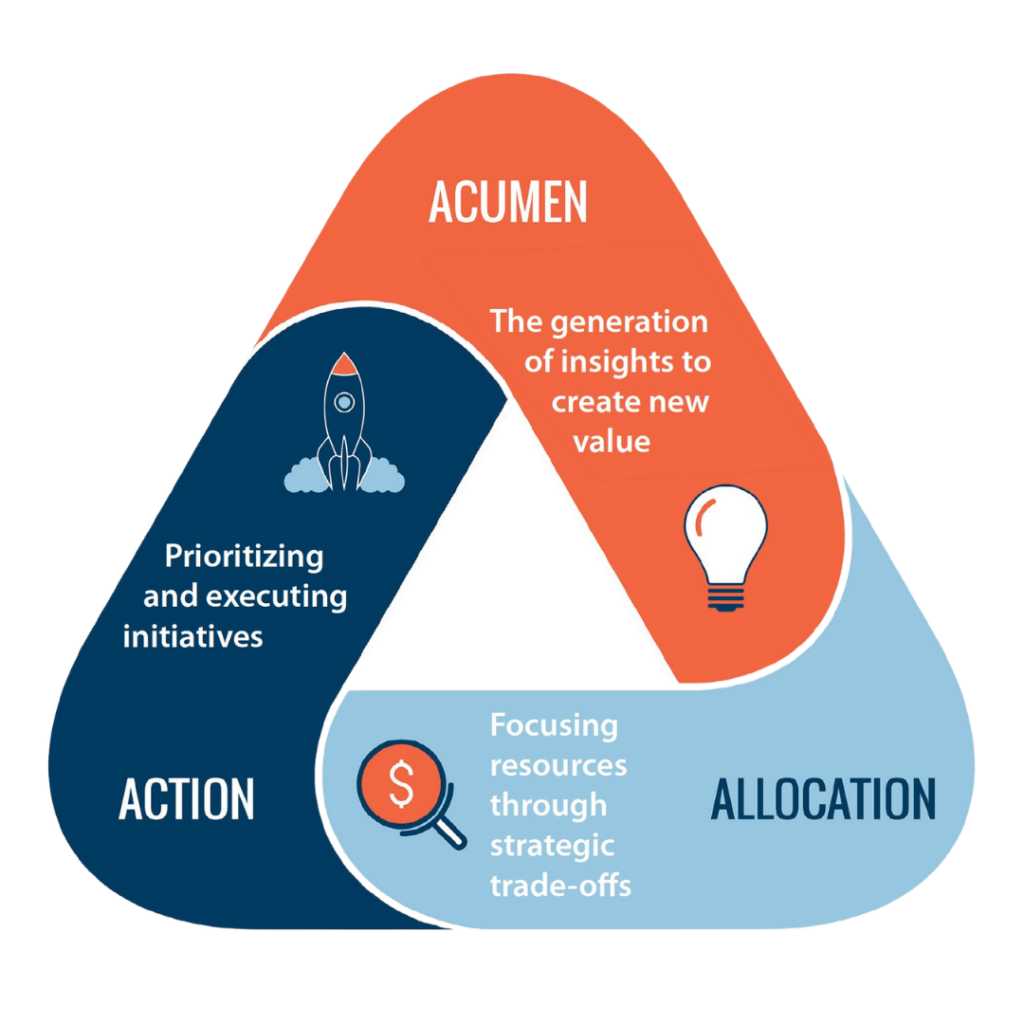“To me, the single most important skill needed for any CEO today is strategic acuity.”
Indra Nooyi, former CEO, Pepsi.
A popular mantra today is “fail fast and fail often.” If you follow this practice as a senior leader, research shows you will soon be an unemployed senior leader. Author Dan Ciampa’s research published in the Harvard Business Review found that one-third to one-half of new chief executives fail within their first 18 months. As Twitter co-founder Jack Dorsey said, “What’s the worst advice you see or hear given in your trade? ‘Fail fast!’” With several studies identifying the number one cause of business failure as bad strategy, taking the time to think strategically and plan appropriately provides a more favorable path to “succeed fast and often.” Let’s replace “Fail fast,” with “Think first.”
The Importance of Strategic Thinking
It’s a given that C-Suite leaders will encounter challenges and times when goals are not met. The key is to mine those moments for strategic insights and transform those learnings into practical action to move the business forward. As Harvard Business School professor Boris Groysberg writes, “For the senior-most executives, functional and technical expertise has become less important than understanding business fundamentals and strategy…To thrive as a C-level executive, an individual needs to be a good communicator, a collaborator, and a strategic thinker.”
In my work facilitating strategy sessions with executive management teams, I’ve been privileged to learn from some of the best minds in business. There are three disciplines I’ve observed in highly successful executives that you can leverage to become more strategic and effective in your role:
Acumen: The generation of insights to create new value.
Allocation: Focusing resources through strategic trade-offs.
Action: Prioritizing and executing initiatives.

Using Strategic Thinking to Generate Insights and Innovation
Acumen for C-Suite executives begins with ensuring that all of your people are accountable for contributing new ideas that lead to customer and organizational value. I’ve worked with several leaders in the technology sector to enhance their organization’s generation of insights that then flow through insight networks that connect people and their ideas across functions and levels.
Some have taken this a step further by assigning accountability to their direct reports for harnessing insights from their teams on a monthly basis and generating “Insight Updates” across the matrix. This means that everyone is contributing ideas on how the business can be more effective, efficient, and innovative, creating a true learning organization. As Apple CEO Tim Cook said, “We want ideas coming from all 80,000 people, not five or three. A much smaller number of people have to decide and edit, and move forward, but we want ideas coming from everywhere.”
Another valuable aspect of Acumen for the C-Suite leader is the evolution of their business model. The business model represents how your team creates, delivers, and captures value. Within these three phases of the business model, it’s important as a senior leader to be crystal clear on core competencies (areas of expertise), capabilities (resources and activities), value proposition (external value), value chain (internal value) and profit channels (revenue models). Ensuring your executive team invests time in thinking through the future state of the business via interactive workshops can lead to exciting new opportunities, often times without involving significant new capital expenditure.
How much time is your C-Suite team investing in thinking about and discussing the future state of the business?
Business Acumen for Strategic Planning
Allocation for C-Suite executives begins with active disengagement. Inventory the areas where your time, talent, and budget are currently being spent and then match those aggregates with your priorities. You’ll be amazed at how much time and budget is continuing to be invested in areas that don’t yield value. Then have the guts to pull the plug on things that aren’t working—not slowly over nine months—now! Research by Donald Sull of the MIT Sloan School of Management shows that 80 percent of mid-level managers say their senior leaders fail to kill unsuccessful initiatives quickly enough. How many tasks and initiatives are your team currently working on that add little value while sucking up the time and energy of your best people? Do something about it.
Another valuable aspect of Allocation for the senior leader is delegation. To delegate means to commit decisions, powers, and functions to other people. One of the principles I help leaders develop is the ability to “Lead at Your Level.” It’s common and comfortable to spend time doing things you’ve done in previous leadership roles, despite the fact that they can and should be done by your direct reports. Research by authors Birkinshaw and Cohen published in the Harvard Business Review shows nearly half (41 percent) of activities that managers work on are actually tasks that should be delegated to others. As a senior executive, create leadership guardrails to provide expectations to your team on what is “in their lane” and indications that they are straying off course. Finally, a highly productive exercise I lead with executive teams is to conduct a decision inventory and then categorize the most common decisions and assign decision rights so that delegation and accountability become ingrained in the culture.
What are your three key strategic trade-offs and how often are you reallocating resources to leverage them?
Strategic Thinking Increases Collaboration
Action for C-Suite executives begins with a more strategic approach to their time. A Harvard Business School study conducted by professors Porter and Nohria of 60,000 CEO hours identified the CEO’s largest time commitment is meetings, at 61 percent of their time. Since meetings are on average the largest consumer of a senior leader’s time, they need to be as productive and efficient as possible. Currently, they are not. A whopping 71 percent of executives say that their meetings are unproductive and inefficient. To add insult to injury, half of all companies surveyed indicated senior leaders’ meeting agendas were either exactly the same or completely ad hoc. One of the core elements of the Strategic Meeting Framework I’ve designed to help executive teams maximize their time together is a checklist with items such as intent (purpose of the meeting), decisions (identifying to-do’s and not-to-do’s) and insights (recording key learnings).
Another valuable aspect of Action for the C-Suite executive is a personal time audit. One of the revelations new senior leaders experience is that an increased percentage of their time is not their own. More and more people want individual and group interaction with you as a senior leader, sometimes for productive intentions and sometimes as a badge to boost their perception of importance in the eyes of colleagues. Either way, a strategic leader controls their time with tools, techniques, and discipline. An effective tool to engage is the Time Tracker where you record your time investment in 30-minute increments for a typical week. The next step is to graph the time spent and areas of investment to identify which match with your priorities and which do not. As Tom Gentile, CEO of Spirit AeroSystems said, “Think about your time very strategically, because it is part of your strategy. You can’t let it be a reactive process that bubbles up from the bottom. You have to manage it from the top down.”
How effectively do your actual time investments match up with your priorities?
The 3A Strategic Framework of Acumen, Allocation, and Action can be an effective mental model to help you become a truly strategic leader. It requires the discipline to prioritize learning, harness your team’s best thinking, and set a course to continually overcome challenges in the pursuit of excellence. Being a senior leader should not be dictated by years on the job, but by the expertise and value a person brings. It’s an honor to lead people, so approach it as such. Do it strategically with a hunger for new insights and you’ll make the most of the opportunity. Do it tactically with complacency and you won’t do it for long.
